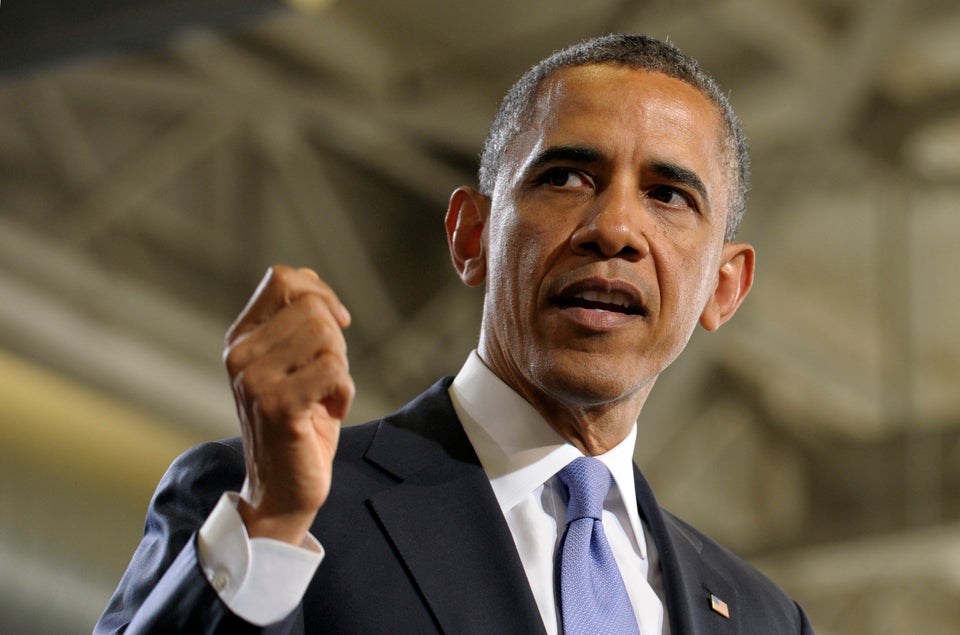WASHINGTON -- The unveiling of President Barack Obama's budget on Wednesday morning has restarted the ongoing debate over how best to pursue deficit reduction.
The president's proposal couples tax hikes with cuts to the federal government's safety net for the poor and elderly to achieve $1.8 trillion in deficit reduction over 10 years. Alongside an austere House Republican budget and a more progressive-minded Senate Democratic blueprint, the White House pitched its proposal as a "serious" effort towards finding "middle ground."
Lost in the analysis is that the White House budget acknowledges the nation is still in the midst of a jobs crisis but provides few new ideas to address the problem. The $3.7 trillion budget includes a variety of stimulative measures, some of which are new. But lawmakers have seen most of them before and aren't any likelier to pass them now.
"It sounds like the White House just tossed last year's budget into the microwave," Sen. Mitch McConnell (R-Ky.), the Republican leader in the Senate, said Wednesday.
The plan includes $1 billion to launch a network of "manufacturing innovation institutes" to encourage public-private partnerships and boost the manufacturing industry, reprised from Obama's 2013 budget. Also included are $50 billion worth of infrastructure investments and the infrastructure bank, both familiar from the president's 2011 American Jobs Act. And the new budget would boost the federal minimum wage to $9 per hour. Obama championed the idea of raising the federal minimum wage during his 2008 campaign but did not bring it up again until his most recent State of the Union address.
A closer read reveals even more detailed suggestions. The budget would set aside $113 million for the Department of Commerce to provide targeted financial aid to specific manufacturing communities. It would appropriate $25 million to launch industry-specific Manufacturing Technology Acceleration Centers. It would spend $200 million for "innovation-spurring transportation investments" that showed "resilience to extreme weather and other impacts of climate change." It would include $1 billion for the Next Generation Air Transportation System; $150 million for a Workforce Innovation Fund; and $25 million to support "efforts to improve employment outcomes for older Americans."
Among the new proposals are a $200 million performance reward for state governments that best cut energy waste and modernize their electricity grids and a $10 billion proposal for school reconstruction bonds. On the tax side, the budget would increase the Child and Dependent Care Tax Credit available to families with incomes between $15,000 and $103,000 and make permanent the tax credits for the production of renewable electricity and for hiring veterans. It would also adjust rules to make it easier for global pension funds to make infrastructure investments in the United States.
"He views it as a fiscally responsible plan for middle-class jobs and growth," a senior administration official, who insisted on speaking on condition of anonymity, told reporters on Tuesday. "What the budget helps to do is break the false choice between deficits and job creation."
But while the White House says it is deeply committed to passing the above stimulus measures, they have no clear path to do so. In a briefing with small group of reporters on Tuesday, another senior administration official noted that the only thing congressional Republicans hate more that tax increases is government-funded stimulus.
The president's aides have said they would be willing to sign off on new entitlement reforms if Republicans would agree to new tax hikes. When asked if they would make the same deal for economic stimulus measures, the top official acknowledged that the administration had not actually considered such an idea -- suggesting that the White House's strategy is more geared toward passing a deficit reduction package.
Even if stimulus measures were passed, they could be blunted by spending cuts the White House is pursuing. The Obama budget turns off the sequester that went into effect at the beginning of March, but it includes sharp reductions elsewhere.
On taxes and social insurance programs, the new Obama budget includes much of his final attempt at a "grand bargain" during fiscal cliff negotiations at the end of last year. That includes $400 billion in health care spending reductions and a change in the way the government measures inflation for Social Security cost-of-living adjustments and tax brackets. Administration officials concede that that adjustment, known as chained-CPI, would result in a tax increase for some middle class families. Economists generally consider lower safety-net spending and less take-home pay for the middle class to be harmful to the economy.
In addition to cuts to social insurance or automatic entitlement programs, the White House budget reduces discretionary spending in familiar ways. The budget calls for a $202 billion reduction in discretionary spending over the next 10 years. That includes cuts to a wide variety of initiatives, including hundreds of millions from the Low Income Heating Assistance Program, which helps poor people heat and cool their homes in the winter and summer. The budget trims heating assistance to $3.02 billion, a reduction of $346 million from what was left after "sequestration" cuts took away $175 million starting in March.
In one of its more memorable demonstrations of willingness to anger the base in the name of deficit reduction, the White House announced early in 2011 it wanted to cut the heating budget by 50 percent, which at the time would have meant reducing the program's allotment to $2.5 billion.
The eventual cut turned out to be smaller, and mild winters coupled with low fuel costs limited the damage. But the continued reductions worry advocates of the program. The latest round of deficit hawkery means roughly 1 million fewer households could receive assistance, according to the National Energy Assistance Directors' Association. Currently, 6.9 million Americans get energy help from LIHEAP.
"It's a gradual wearing-away of the program," NEADA director Mark Wolfe said Wednesday. "It's just one more way of making poor people's lives harder."
